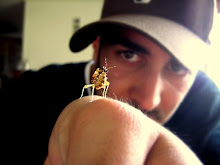This week I have the distinct honor of posting an article written by a man I admire very much, primate conservationist Vernon Reynolds! Please read!
Snare removal by a chimpanzee
by Vernon Reynolds
Introduction
In the Budongo Forest, in Africa, local hunters put out snares to catch duikers (small antelopes) and pigs. The snares are in the form of a noose, made of wire or nylon. The hunters are poor village people and unable to buy meat, and this is how they manage to get some protein for the cooking pot. Unfortunately, chimpanzees which live in the forest do sometimes get caught in these snares
It’s very rare for one chimpanzee to help another to remove a snare. Normally if a chimp gets caught in a snare, it has to try and remove it itself. Sometimes they succeed, other times the snare just stays on the wrist or ankle for a long long time. Sometimes the wound gets infected and the individual may die as a result. Other times the hand or foot becomes useless and hangs limply while the poor chimp has to walk and climb with three limbs only. In really bad cases a chimp can get caught more than once. Amazingly, chimps can survive with two injured limbs but life is very hard for them.
All this we know because of our studies at the Budongo Forest in Western Uganda. I first went there with my wife Frankie in 1962 and we spent the best part of a year there studying chimps. We returned to Europe and Idi Amin came to power in Uganda. We kept clear of the country during its two devastating civil wars, from 1971 - 1986. In 1990 I started the Budongo Forest Project again . Today we are a Ugandan NGO with the name Budongo Conservation Field Station. We have a Ugandan director and a Ugandan staff. Our Scientific Director and Assistant Director are Europeans, but we are very much a Ugandan project.
Chimpanzee removes a snare
On January 18, 2008 one of our Field Assistants, Stephen Amati, was with a party of 27 chimps in the forest. At 16:53 one of our senior and respected adult female chimps, Kwera, started to scream, and other chimps joined in. Kwera’s right hand had become caught in a nylon snare attached to a tree sapling. Here is how Stephen tells the story:
“A couple of minutes after she got caught, the alpha male Nick arrived and displayed at Kwera, who was immobilised. After hitting Kwera a couple of times, Nick stopped and sat next to her. Nick broke off the small sapling so that Kwera was able to move again. However the snare was still around her hand, which was still attached to a stick of about 30 cm.
“The party continued travelling towards the south. At 17:18 the party started to move through an area of thick undergrowth, quite common in Budongo Forest. The stick attached to Kwera’s snare got stuck between the little trees. Again she started to scream while pulling on the snare. Nick came back and displayed again towards her. He pulled on the stick which made Kwera scream more. Kwera presented to him and Nick started grooming her. While being groomed, Kwera manipulated the snare with her teeth trying to bite through the nylon string. After 5 minutes, Nick took Kwera’s right arm, held it up and investigated the snare. He started to manipulate the nylon with his teeth while holding Kwera’s arm and the stick firmly in position. After a few minutes the snare fell off and the party continued moving.”
This is the first time we’ve seen a snare removed from one chimpanzee by another chimpanzee at Budongo and there are very few reports from elsewhere. This is perhaps surprising given the high intelligence of chimpanzees, but it is a fact nonetheless. Most chimps who get a snare are left to fend for themselves and suffer accordingly. But as this case shows, it is possible for chimps to cooperate and get a snare off. We hope this habit may spread within our community of chimps! Well done Nick, and also well done Kwera for allowing him to do this, it must have been a very painful experience.
Acknowledgment
The full account of this event was published in Pan Africa News, the Newsletter of the Committee for the Care and Conservation of Chimpanzees and the Mahale Wildlife Conservation Society, June 2008. I wish to express grateful thanks to the Editors of Pan Africa News for permission to publish this story, which was initially written by Stephen Amati, Fred Babweteera, and Roman Wittig.
Budongo Conservation Field Station (BCFS)
PO Box 362, Masindi, Uganda
Email: bcfs@utlonline.co.ug
Pan Africa News
Japan Monkey Centre
26 Kanrin
Inuyama, Aaichi 484-0081
Japan
Email: pan.editor@gmail.com
This article was written by Vernon Reynolds (Associate Editor, PAN and Advisor, BCFS)
Subscribe to:
Post Comments (Atom)

2 comments:
Why is it that the Chimps don't help each other out more? Are there any theories about this? I don't know much about Chimps other than their high levels of intelligence. Any thoughts?
Chimps are extremely intelligent, and their intelligence is an adaptation to help them survive. Most adaptations that animals have evolve over a long period of time, and the wire and nylon snares used for hunting bushmeat is a relatively new problem that chimps have had to adapt to. The awesome thing about chimps is that they have specific cultures to each of their groups, cultures that consist of traditions that are passed on by elders to the youngsters. What we all hope to see is more chimps learning how to help each other out of snares and passing on the knowledge to their fellow group members as well as their young, so fewer and fewer will have to suffer because of the traps. I believe it's absolutely possible, and we are just beginning to see it happen.
Post a Comment